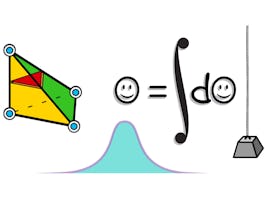This first course on concepts of single variable calculus will introduce the notions of limits of a function to define the derivative of a function. In mathematics, the derivative measures the sensitivity to change of the function. For example, the derivative of the position of a moving object with respect to time is the object's velocity: this measures how quickly the position of the object changes when time advances. This fundamental notion will be applied through the modelling and analysis of data.

Schenken Sie Ihrer Karriere Coursera Plus mit einem Rabatt von $160 , der jährlich abgerechnet wird. Sparen Sie heute.


Calculus through Data & Modeling: Limits & Derivatives
Dieser Kurs ist Teil von Spezialisierung Differential Calculus through Data and Modeling

Dozent: Joseph W. Cutrone, PhD
TOP-LEHRKRAFT
7.368 bereits angemeldet
Bei  enthalten
enthalten
(190 Bewertungen)
Wichtige Details

Zu Ihrem LinkedIn-Profil hinzufügen
5 Quizzes
Erfahren Sie, wie Mitarbeiter führender Unternehmen gefragte Kompetenzen erwerben.

Erweitern Sie Ihre Fachkenntnisse
- Lernen Sie neue Konzepte von Branchenexperten
- Gewinnen Sie ein Grundverständnis bestimmter Themen oder Tools
- Erwerben Sie berufsrelevante Kompetenzen durch praktische Projekte
- Erwerben Sie ein Berufszertifikat zur Vorlage


Erwerben Sie ein Karrierezertifikat.
Fügen Sie diese Qualifikation zur Ihrem LinkedIn-Profil oder Ihrem Lebenslauf hinzu.
Teilen Sie es in den sozialen Medien und in Ihrer Leistungsbeurteilung.

In diesem Kurs gibt es 6 Module
One of the goals in studying Calculus is to analyze rates of change and movement. In this module, we introduce the central ideas which will help us achieve this goal: the notions of the limit and the derivative. Rather than evaluating a function at a single point, the limit allows for the study of the behavior of a function in an interval around that point. In this module, you will find limits of functions by a variety of methods, both visually and algebraically. Finally, we will apply limits to define the key idea of Differentiable Calculus, the derivative.
Das ist alles enthalten
5 Videos2 Lektüren1 Quiz
Using calculators or graphs is an imprecise way to find the limit of a function. In this module, we will state and use algebraic properties of limits, called the Limit Laws, to calculate the exact values of limits. A solid understanding of these laws will allow us to derive theorems which in turn can be used to study the behavior of more advanced functions.
Das ist alles enthalten
3 Videos1 Lektüre1 Quiz
In the last module, there were several types of functions where the limit of a function as x approaches a number could be found by simply calculating the value of the function at the number. Functions with this property will be called continuous and in this module, we use limits to define continuity. We will see that the mathematical definition of continuity will correspond closely with the English meaning of the word continuity used in every day language.
Das ist alles enthalten
3 Videos2 Lektüren1 Quiz
In this module, we allow for x to become arbitrarily large in the positive or negative direction to understand the end-behaviors of functions. This will allow for the formal definition of a horizontal asymptote and to provide classifications of end-behavior of certain types of functions.
Das ist alles enthalten
1 Video2 Lektüren1 Quiz
The problem of finding the slope of the tangent line to a curve and the problem of finding the instantaneous velocity of an object both involve finding the same type of limit. This special type of limit is called the derivative and in this module, we will see that this notion of the derivative can be interpreted as a rate of change in any of the natural or social sciences or engineering.
Das ist alles enthalten
7 Videos2 Lektüren1 Quiz
In this final project, we will apply the tools and language of differentiable calculus to analyze trends in data. This project will focus on modelling and analyzing gender ratios in educational attainment over time in several regions of the world.
Das ist alles enthalten
1 peer review
Dozent

Empfohlen, wenn Sie sich für Math and Logic interessieren

University of Pennsylvania

Johns Hopkins University

Johns Hopkins University

University of Pennsylvania
Warum entscheiden sich Menschen für Coursera für ihre Karriere?




Bewertungen von Lernenden
Zeigt 3 von 190
190 Bewertungen
- 5 stars
84,21 %
- 4 stars
10,52 %
- 3 stars
2,63 %
- 2 stars
1,05 %
- 1 star
1,57 %
Geprüft am 22. Juni 2021
Geprüft am 31. Mai 2021
Geprüft am 15. März 2022

Neue Karrieremöglichkeiten mit Coursera Plus
Unbegrenzter Zugang zu über 7.000 erstklassigen Kursen, praktischen Projekten und Zertifikatsprogrammen, die Sie auf den Beruf vorbereiten – alles in Ihrem Abonnement enthalten
Bringen Sie Ihre Karriere mit einem Online-Abschluss voran.
Erwerben Sie einen Abschluss von erstklassigen Universitäten – 100 % online
Schließen Sie sich mehr als 3.400 Unternehmen in aller Welt an, die sich für Coursera for Business entschieden haben.
Schulen Sie Ihre Mitarbeiter*innen, um sich in der digitalen Wirtschaft zu behaupten.
Häufig gestellte Fragen
Access to lectures and assignments depends on your type of enrollment. If you take a course in audit mode, you will be able to see most course materials for free. To access graded assignments and to earn a Certificate, you will need to purchase the Certificate experience, during or after your audit. If you don't see the audit option:
The course may not offer an audit option. You can try a Free Trial instead, or apply for Financial Aid.
The course may offer 'Full Course, No Certificate' instead. This option lets you see all course materials, submit required assessments, and get a final grade. This also means that you will not be able to purchase a Certificate experience.
When you enroll in the course, you get access to all of the courses in the Specialization, and you earn a certificate when you complete the work. Your electronic Certificate will be added to your Accomplishments page - from there, you can print your Certificate or add it to your LinkedIn profile. If you only want to read and view the course content, you can audit the course for free.
If you subscribed, you get a 7-day free trial during which you can cancel at no penalty. After that, we don’t give refunds, but you can cancel your subscription at any time. See our full refund policy.

